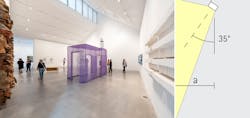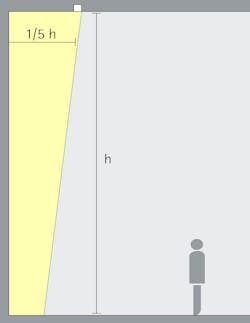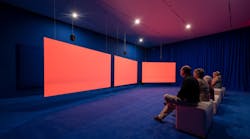Fifty years ago, ERCO launched its first wall washers on the market, revolutionizing the approach to vertical lighting design. Today, wall washing remains an essential lighting technique.
Vertical lighting is a fundamental element in architectural lighting for both design and normative reasons. Under identical levels of illuminance, a vertical surface produces a higher impression of brightness than a horizontal surface because walls are in our natural field of vision. Less lighting, and thus energy, is required in illuminating walls versus the floor for a similar impression of brightness; for example, illuminating walls instead of floors with 100 lux will make a room appear three to five times brighter.
Why wall wash
Wall washing can fulfill several design needs. First, it can provide orientation. When we enter a room, we see the brightest surface first. Wall washing makes clear the axes of architecture and helps us to comprehend different functional areas and spatial transitions. Lighting thus creates recognizable entrance zones.
Second, wall washing creates brightness. A room only appears bright when its walls are evenly illuminated. High reflectivity on the wall can significantly increase our impression of brightness.
Next, wall washing can contribute to greater visual comfort in environments like offices. Light on walls helps reduce the contrast between self-illuminated screens and the visual surroundings. A bright background creates a lighting effect that is pleasant to the eye and prevents fatigue.
Fourth, uniformly illuminated walls can create distance and even visually expand the dimension of a room. Narrow rooms can seem more comfortable, while bright walls can zone and provide structure to large areas. In high spaces such as atriums, if daylight from one side of the room does not reach the opposite wall, wall washing can compensate for the missing light.
Finally, wall washing can help emphasize the texture of finishes, such as stone. Grazing light highlights surface textures through the high-contrast interplay of light and shadow. Wall washers installed either in the floor or ceiling and positioned close to the wall can achieve this effect.
5 tips for optimal wall washing
Wall washing describes an even lighting distribution on vertical surfaces. The color rendering index of light sources will depend on the objects to be illuminated, such as artwork. Likewise, the lumen output will depend on the height of the room.
Below are five tips for achieving the appropriate wall wash.
1. Identify the ideal luminaire placement and spacing.
Ceiling-recessed wall washers blend into the background, allowing the room to become the focal point. The optimal horizontal distance from the wall to position wall washers is equal to one-third the room height. As a general rule of thumb, the luminaire spacing—the on-center distance between wall washers—should be 1.2 to 1.5 times the distance from the wall. Regardless of how near or far the wall washers are located, ensure that sufficient light reaches the base of the wall.
2. Use track wall washers for flexible solutions.
Temporary exhibitions require flexible lighting solutions, such as wall washers from spotlight ranges that can be positioned in a track. Still aim for a horizontal distance to the wall of one-third the room height. For optimal uniformity on the wall, incline track luminaires at a 35-degree angle from the vertical axis.
3. Use grazing light for special effect.
In areas where uniform wall illumination is less important, linear wall grazers for ceiling or floor installation can emphasize materials and textures through the play of light and shadow.
4. Illuminate corridors evenly with double wall washers.
Wall washing can create a bright spatial impression in narrow environments, such as corridors. A row of double wall washers can uniformly and efficiently illuminate opposite walls from ceiling to floor.
5. Shorten horizontal wall distances in tall rooms.
For rooms with ceilings exceeding 8 meters (26 feet) in height, positioning wall washers at a horizontal distance of one-third the room height can become challenging. Instead, try placing wall washers at a distance equal to one-fifth the room height. For good horizontal uniformity in light, space wall washers at a distance equal to or less than 1.3 times their horizontal distance to the wall.













